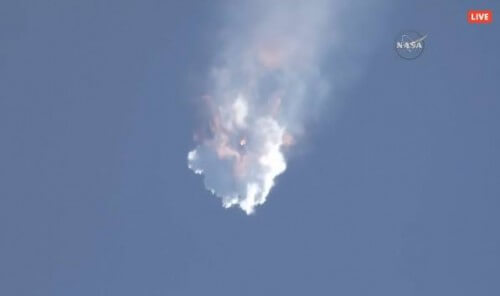This is the third cargo spacecraft that does not reach its destination in the last year. SpaceX and NASA say that the malfunction will be thoroughly investigated * Watch the moment of the explosion, and the NASA press conference a few hours after the event

An unmanned mission of a SpaceX Falcon 9 launcher ended in failure after the launcher exploded in the air two minutes and 19 seconds after launch from Cape Canaveral at 17:20 Israel time. The launcher was carrying a Dragon supply spacecraft to the International Space Station. The launcher disintegrated when it reached a speed of 4,300 km/h at an altitude of about 42 km above the Atlantic Ocean.
During the launch that was broadcast live on NASA TV, they saw that the launcher started to smoke and then the disintegration could be seen live.
A spokesman for the SpaceX company who participated in the broadcasts of one of the television stations hypothesized that the launcher was able to reach supersonic speed, but something happened before the spacecraft was able to detach the first stage of the launcher and reach orbit. The company stated that everything went smoothly until the moment when the missile exceeded the speed of sound.
This is a particularly serious fault because, unlike Orbital Sciences, SpaceX, which is owned by the businessman Elon Musk, was also among the winners of the tender to launch humans into near space and is now developing systems for manned launches based on the same technologies used by the launchers and the unmanned spacecraft.
NASA Administrator: We are disappointed by the explosion of the SpaceX rocket
NASA Administrator Charles Bolden issued a statement to the media following the disintegration of the SpaceX launcher carrying a cargo spacecraft to the space station. This is the seventh flight of the Falcon 9 launcher and the Dragon supply spacecraft.
"We are disappointed by the loss of SpaceX's cargo spacecraft on a mission to resupply the International Space Station. However, the astronauts aboard the station are safe and have enough supplies for the coming months. A Russian Progress resupply spacecraft is ready for launch on July 3, followed by the launch of a Japanese HTV spacecraft. Orbital, the carrier of our second payload, is making progress with its plans to launch an additional supply spacecraft later this year."
Bolden added, "NASA will work closely with the SpaceX people to understand what happened, fix the problem and get back to flying." The commercial cargo program was also designed to contain redundancy in case of loss of cargo spacecraft. We will continue to operate the station in an efficient and safe way and will continue to use it as a testing ground to prepare for long-term missions deep into the solar system."
"SpaceX has demonstrated amazing capabilities and its first six cargo spacecraft have arrived at the station, so we are confident they can replicate this success." Bolden writes.
We will investigate together with SpaceX and help them find out what happened, understand the specific circumstances of the malfunction and fix it in order to move on. It's a reminder that space missions are a huge challenge, but we learn from every success and every failure. Today's launch attempt will not stop us from continuing the ambitious program of manned space flights."
Third failure within a year
The last year was full of malfunctions when a supply spacecraft of the second private company that provides cargo launch services to NASA. on October 29, 2014 An Orbital Science company's Antares launcher exploded and a Cygnus model supply spacecraft on it. and on April 29 A Soyuz model launcher of the Russian space agency has disintegrated who brought with him a Progress model supply spacecraft, which later crashed on Earth.
The cargo spacecraft had spare parts for systems lost in the two previous lost missions. This is a big setback for NASA because the company now depends on private industry to upload cargo and in the future also humans to the station. As mentioned, this is the third cargo spaceship that does not reach its destination in the last year. SpaceX and NASA say that the malfunction will be thoroughly investigated.
It was the first failure in which a Falcon 9 launcher exploded during a commercial launch, In August 2014, a model launcher that was supposed to replace the Falcon 9 exploded - the so-called Falcon 9 Reusabkle and its name, intended for reuse.
This past year was full of malfunctions when a supply spacecraft of the second private company that provides cargo launch services to NASA. On October 29, 2014, an Orbital Science company's Antares launcher with a Cygnus supply spacecraft on it exploded. And on April 29, a Soyuz-type launcher of the Russian space agency that brought a Progress-type supply spacecraft with it disintegrated, which later crashed on Earth.
A spokesman for the SpaceX company who participated in the broadcasts of one of the television stations estimated that the launcher was able to reach supersonic speed, but something happened before the spacecraft was able to detach the first stage of the launcher and reach orbit.
Interpretation: In space launches, failure is always an option

6 תגובות
Shame on video
I am.
Not jealous of investors